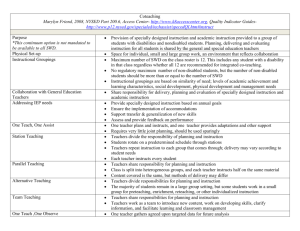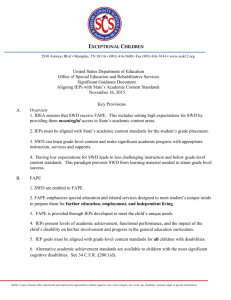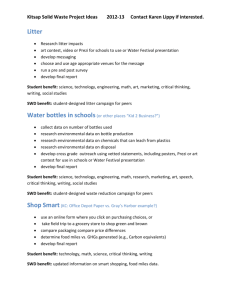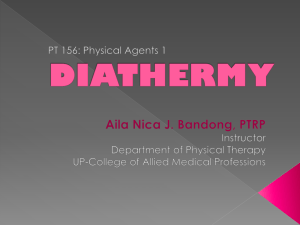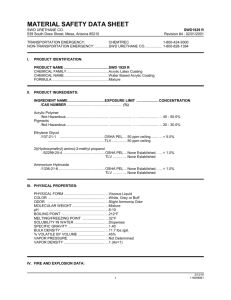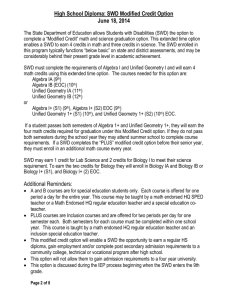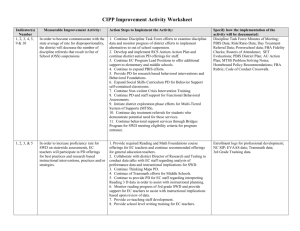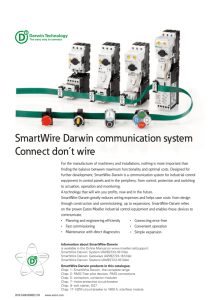Fact that we are here—awesome
advertisement
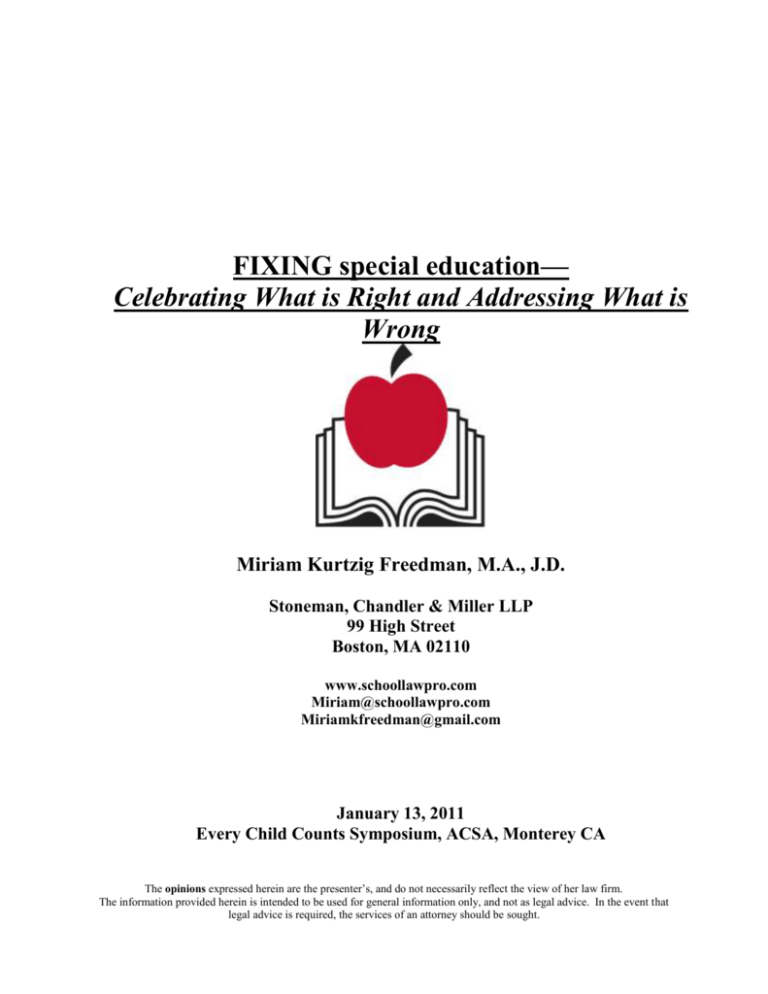
FIXING special education— Celebrating What is Right and Addressing What is Wrong Miriam Kurtzig Freedman, M.A., J.D. Stoneman, Chandler & Miller LLP 99 High Street Boston, MA 02110 www.schoollawpro.com Miriam@schoollawpro.com Miriamkfreedman@gmail.com January 13, 2011 Every Child Counts Symposium, ACSA, Monterey CA The opinions expressed herein are the presenter’s, and do not necessarily reflect the view of her law firm. The information provided herein is intended to be used for general information only, and not as legal advice. In the event that legal advice is required, the services of an attorney should be sought. MIRIAM KURTZIG FREEDMAN, M.A., J.D. Reformer, Lawyer, Speaker, Author Goals: To promote systemic reform in special education, through innovation, climate change, and‘Trust-based Special Education’™ nationwide. To build practical knowledge and understanding of special education and ‘504’ for educators, administrators, parents, and policy makers. To encourage excellence in educating ALL students through books, speaking, and consultations. Experience: Respected authority with an outspoken perspective to change the climate in the special education arena. Attorney at Boston law firm of Stoneman, Chandler & Miller LLP since 1988, representing school districts. Massachusetts Hearing Officer for eight years; public school teacher in California, New Jersey, New York and Massachusetts. Visiting fellow at Stanford University for the past six years. Reform achievements: Co-founder Special Education Day and Special Education Day Committee (SPEDCO) to honor special education’s achievement and spur reform. The Massachusetts Department of Elementary and Secondary Education funds and administers one of SPEDCO’s reforms, SpedEx—a childcentered resolution model. The Procedures Lite reform is piloted by schools. Pioneer Institute Runner Up in Better Government Competition (2004, 2007 (co-authored)). Author and presenter Fixing Special Education—12 Steps to Transform a Broken System. Authorships: Special reports, six books in the education and law fields, and articles, including two Hoover Institution publications (Education Next and Hoover Digest), several in Education Week and Education News interviews. Please visit www.schoollawpro.com. Professional memberships: Fordham Institute “brainstorming session” on new directions for special education (2010); National Governors Assessment Board’s (NAGB) Advisory Panel on Uniform National Rules for Testing Students with Disabilities for the NAEP, the ‘Nation’s Report Card.’ (2009). MA Commissioner’s Advisory Panel on MCAS Accommodations (2008-9). National Speakers Association (former board member, New England chapter). Education Consumer Consultants Network. MA Bar Association. Founding member of SPEDCO. Education: LLB New York University School of Law MA University of New York at Stony Brook BA Barnard College (Columbia University) Early education in Israel (Palestine), Holland, and New Jersey 2 Thank you! The fact that we are here—discussing this challenge—is awesome. Full of AWE! AMAZING! 35 years after the IDEA began, it is time for a tune up. ABSTRACT: The need and push for a special education law began because many students with disabilities (SWD) were denied access to public education and/or did not receive appropriate services in the 1950’s, 60’s and 70’s. That was then. Now, almost 35 years since the law was passed, special education is everywhere and affects all schools in our country. It has fostered great progress and success, as well as many unintended consequences. It is time for us to ask: Is the law still on the right track? What are the true costs of its many regulations, procedures, and bureaucratic requirements? Is it effective and outcomes-driven? Does it promote teaching and learning? Does it enhance trust? Do we know who is ‘special’? Can special education balance the public good with individual rights? Is it working effectively for ALL students, including SWD? Does it promote teaching and learning for ALL? Or, does it need systematic reform? The answer to this last question is a resounding ‘YES.’ After 35 years, it’s time for a tune up of the IDEA! Ask yourself: What option should we pursue when a law succeeds and achieves its mission? Should we end it, change its mission, just ‘keep on keeping on?’ Unfortunately, we followed the third option. We kept the law, adding more regulations, bureaucratic requirements, and legal ‘rights’ and entitlements—even as its mission of providing access to all SWD to appropriate programs was accomplished long ago. I believe the climate is right to change this path and tackle systemic reform of special education at the national (and state) level. Events shift. Times change. Five years ago may have been too soon. Many of us now see how dysfunctional the system has become in the context of school reform for ALL children in our schools. My book and efforts focus on the 70% of SWD generally considered to have milder disabilities, not the 30% of SWD who have more profound and severe disabilities—and for whom this law was written. Let’s look at the challenge in three ways: success, realities, and forward looking, common sense Solutions. 1. Eleanor’s story. Time to celebrate our success. How did we get here? In 1975, President Gerald Ford signed the nation’s first special education law because, at the time, some one million children were excluded from schools or received no appropriate services. Then called the EHA, the law is now the IDEA (Individuals with Disabilities Education Improvement Act). It was designed to ensure that all eligible SWD had access to a free appropriate public education (called a FAPE) in the least restrictive environment (LRE). A FAPE is an individualized program, set forth in a student’s IEP (Individualized Education Program). An IEP is designed to provide an educational benefit for a child through…“specialized instruction that is designed to meet the individual needs of the child in the 3 [LRE].” The law set up a complex system of parental rights, student entitlements, bureaucratic requirements, and a due process system to resolve disputes about FAPE. Today, some 14% of all students are educated under this law nationwide. In California that percentage is closer to 10%. More than 6.5 million students receive special education nationwide! As a result of years of focused attention and commitment by schools and families, many SWD receive appropriate services, succeed in our public schools, graduate from high school, move on to further education, enter the nation’s workforce, and become productive citizens. For that progress we are grateful and honor the success achieved over the past almost 35 years in providing educational opportunities for SWD. Since 1975, everything changed. Even our language changed; how distant are the labels ‘educable,’ ‘trainable,’ and ‘noneducable.’ That terminology is long gone, replaced by today’s mantra: ‘All students can learn.’ Our language tracks the revolution. We now live in an inclusive society. All Eleanors are in school. We did it!—Teachers, parents, administrators, legislators, taxpayers, etc. etc. etc. 2. Unintended consequences The law of unintended consequences… The law set up an adversarial system, based on the premise that too often Schools and parents are NOT on the same page working on behalf of the child in good faith. PARENTS are called upon to ADVOCATE FOR their child—alas, AGAINST their school. reserved. Copies to be made only upon written permission of author The law’s adversarial due process system contradicts the basic need for TRUST and the overall need to promote teaching and learning in our schools. This law of good intentions and great efforts by schools, students, families, and the entire nation, has spawned a host of unintended consequences that challenge schools nationwide. Consider— 4 The law’s ‘systemic design flaw’ that requires parents to be its enforcers. This flaw has turned out to be unfair, inequitable (as only savvy parents can work the system), and dysfunctional, creating an adversarial climate, instead of cooperation and collaboration between home and school. The law’s systemic design flaw… ….is that parents are its enforcers. Not sustainable! The law created a bureaucracy that is NOT sustainable. It impedes the mission to educate all students, including SWD. Litigation and the fear of litigation continue to be a growth industry. The bureaucratic environment crushes the mission of teaching and learning. We all know that. r Tyranny of paperwork and regulations often overshadows education. o 814 federal requirements (back in 2002!) o Two types of school districts Education by dogma and a rights-based system, not research. E.g. o Input over outcomes o Process over teaching and learning o No research that audits and paperwork improve learning o No research that inclusion meets student needs o No research that process (including due process) improves learning o No research about effective labeling o No research on time left for the task of teaching and learning In sum….. 5 It is……. It is not…. • Rights- based • Learning-based • Belief/dogmabased • Input-driven • Adversarial • So 20th century! • Research-based • Output-resultsdriven • Trust-based • 21st century! uthor The cost for these programs are twice to four times the cost of educating other students. Accurate figures are hard to come by, as funds come from various state, local, and federal programs and cover regular and special education services for SWD. The special education entitlement can upend school policies and budgets, as costs are driven by individual, not broad programmatic needs. Special education and NCLB is a bad marriage of contradictions and confusion. Yet, schools have to implement both. In many ways, NCLB is 21st century; IDEA is so 20th century. And?____________________________________________________________ I believe that we are on the wrong path. More of the same won’t get us where we need to be. The law should have had a sunset provision. Alas, it did not. We need to have our March of Dimes moment. Change the mission to meet 21st century realities and needs! 6 3. Systemic reform, Education.’™ climate change, and ‘Trust-based Special Trust-based Special Education IMAGINE TBSE, based on the premise that educators, parents, and students are on the same page and the assumption that they are working together in GOOD FAITH to improve learning for all students. mission of author Possible solutions include— Change the role of parents from law enforcers to parenting. To do so, see some of Secretary of Education Arne Duncan’s recent speeches! End due process about programming—FAPE in the LRE. o Lawyers or judges should not choose reading programs or how to teach a child with autism. o Doctors? Architects? Do they undergo pre-services litigation? Teachers do. It demeans their professionalism and, I believe, is bad for students. End the labeling—the medical model as gatekeeper. o Teach ALL—where they are. o Students should go to school for an education, not a diagnosis (to quote Don Asbridge, California school psychologist). o What about students who are WBFWR (to quote attorney Jim Walsh of Austin, Texas). Allow only procedures and regulations that promote learning and have research support. For example: o 30 page IEPs—Why? o Paperwork audits—Who benefits? o Time for teaching and learning—How do we expand that? o Inclusion—When is it appropriate and when is it not? Inclusion should be a means, not an end. o Student strengths—We need to focus on this! o Overuse of accommodations—A way to bypass education… o Treat teachers with respect—where will that lead us? Create a positive role for parent and student accountability. 7 Fairness Issues for ALL students—We should not continue to ignore these. Costs—effective, fair, reasonable? CALL TO ACTION I don’t have a dog in this fight. I am passionate to end the unintended consequences of this law and bring us back to where we need to be: focusing on teaching and learning. I believe in the power of small acts that can change the climate. Check out Malcolm Caldwell’s The Tipping Point. We can’t wait for Congress, Beacon Hill, or Sacramento legislators to act. So what to do? Change the climate one step at a time. We are powerful to change the path. No intent to delete rights. Let’s start with efforts that are voluntary, effective, and promote teaching and learning! Let us make the current rights-based, bureaucracy-burdened, input-driven system into an ‘uncool’ dinosaur! Past its prime. So yesterday! Examples of small steps that have big effects underway and where to find more information: 1. Procedures Lite www.specialeducationday.com 2. SpedEx. www.doe.mass.edu/sped/spedx 3. ‘Teachers and Lawyers’ group in Arlington, MA 4. ‘Interventionist’ model, Adams County, Colorado www.sbsadams50.org 5. ‘Plain English’ approach www.plainlanguage.gov 6. Hire an ombudsman, public advocate, a ‘hand holder.’ 7. Special Education Day (December 2) to celebrate success and spur reform www.specialeducationday.com. Mark your calendars! 8. Establish an innovation prize. “You get what you celebrate,” Dean Kamen, Segway inventor. Stay tuned for this effort. 9. And?___________________________________________________________________ ________________________________________________________ What is the reaction to my book? Amazing. People often say, “Thank you for putting into words what we all know.” I hoped to open a national conversation. We’re doing that! 8 Education News interview had more comments than other interviews, leading to two interviews. Bought in bulk by several states and districts; e.g., Colorado, Montana, Texas, Massachusetts, among others. Fordham Institute “brainstorming” session. Public Good book party. And we’re here today! The book has been a conversation starter! Summary The IDEA achieved great success. We live in an inclusive world now. There is no going back. All SWD have access to a FAPE in the LRE. It’s time to focus on student achievement, not acrimony parents as education supporters and partners for students building trust, not an adversarial system teaching and learning, not winning and losing the needs of all students, not just one student our country’s need for excellent results, not compliance The current mission creep (tinkering around the law’s edges and adding bits here and there…. every few years during ‘reauthorization’) is bad public policy. We need mission change—our March of Dimes moment. We need to balance scarce resources and create a system to meet 21st century needs for ALL students. It’s time to roll up our sleeves and get going! The fact that we are here discussing fixing special education—is awesome! Full of AWE! Thank you for your participation! 9 Appendix 1. Procedures Lite 2. SpedEx 3. Song, sung to the tune of Clementine For these attachments or to continue the discussion, please contact Miriam at miriamkfreedman@gmail.com. I will be visiting Stanford Law School in the spring of 2011 and happy to speak to groups and schools that are interested in considering out-of-thebox common sense solutions that bring us back to teaching and learning! Miriam Kurtzig Freedman, M.A., J.D., author of Fixing Special Education—12 Steps to Transform a Broken System School Law Pro.com 10

